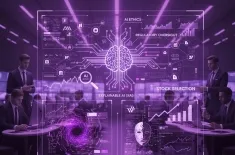how no-code ML platforms and AutoML are creating accessible tools, lowering entry barriers
The rise of Artificial Intelligence (AI) and Machine Learning (ML) has ushered in a new era of technological capability, but for a long time, the power of these tools remained locked within the "ivory towers" of tech giants and specialized research labs. The complexity, cost, and steep learning curve associated with traditional ML development created a significant barrier, limiting its transformative potential to an elite few. However, a profound shift is underway: the AI democratization movement.
This movement is fundamentally about Making complex AI and Machine Learning tools accessible to non-experts through user-friendly interfaces and automated development platforms. It represents a global push to take AI from a niche academic discipline and transform it into an ubiquitous, accessible tool for businesses, educators, small startups, and individual innovators across every sector. The result is a substantial lowering entry barriers to AI development and adoption, which is set to redefine innovation and business strategy for the 21st century.
The Pillars of AI Democratization
The concept of AI democratization is powered by three interconnected technological pillars that simplify the typically laborious and code-heavy Machine Learning pipeline. These innovations collectively enable non-technical users to build, train, and deploy sophisticated AI models, turning once-exclusive capabilities into everyday utilities.
AutoML: Automated Machine Learning
One of the most significant steps toward making AI accessible is AutoML (Automated Machine Learning). Traditionally, building an effective ML model required experts to manually select the right algorithms, engineer features, tune hyperparameters, and validate the model—a process that could take weeks or months.
AutoML platforms automate these critical, time-consuming, and complex steps. They provide a guided environment that handles the "grunt work" of ML development, allowing users to focus on the business problem rather than the intricacies of the code.
- Automated Pipeline: AutoML streamlines the entire ML workflow, from raw data ingestion and pre-processing to model selection and deployment.
- Optimal Model Discovery: Instead of relying on a human to guess the best model, AutoML platforms systematically test thousands of potential algorithms and configurations to find the most accurate and efficient solution for a given dataset.
- Efficiency for Experts: Even for seasoned data scientists, AutoML is a game-changer, reducing development time from months to days, freeing them up to work on more complex, bespoke problems.
No-Code and Low-Code ML Platforms
For the truly non-technical user, the rise of no-code ML platforms has been revolutionary. These tools completely abstract away the need for programming knowledge, operating entirely through intuitive, visual, drag-and-drop interfaces. Users can assemble an entire machine learning pipeline—connecting a dataset, selecting a model type, and deploying the solution—as simply as building with digital LEGO blocks.
Low-code platforms serve as a bridge, offering the visual ease of no-code but allowing professional developers or advanced citizen data scientists to inject custom code where necessary for greater flexibility or complex integration. This tiered approach ensures that AI solutions are not only accessible but also maintain a degree of customizability.
- Visual Development: Users create models by dragging and dropping pre-built components (like data connectors, training modules, and evaluation tools).
- Rapid Prototyping: The speed of no-code ML platforms enables users to quickly test hypotheses and rapidly iterate on solutions, drastically reducing the time-to-market for AI-powered products and features.
Pre-trained Models and APIs
The proliferation of open-source and proprietary pre-trained models—especially in areas like Natural Language Processing (NLP) and Computer Vision—has played a massive role in lowering entry barriers. Large language models (LLMs) and advanced image recognition models are now available as easy-to-use APIs (Application Programming Interfaces).
A developer or business user no longer needs petabytes of data and millions of dollars of compute power to train a model from scratch. They can simply call an API endpoint, sending in their data and receiving a powerful, pre-computed AI output in return. This makes high-end AI capability instantly usable, inexpensive, and scalable for virtually any application.
The Rise of the Citizen Data Scientist
The most profound social impact of AI democratization is the emergence of the citizen data scientist. This term describes an individual who possesses deep domain knowledge (e.g., in marketing, finance, healthcare, or operations) but lacks the formal training of a traditional data scientist.
By equipping these domain experts with accessible tools like AutoML and no-code ML platforms, organizations are empowering them to build models that solve specific, high-value business problems.
- Blending Expertise: The citizen data scientist combines their intimate understanding of the business context with the power of machine learning, leading to more relevant and actionable insights than an expert data scientist might achieve without that domain context.
- Decentralized Innovation: This shift moves AI development from a centralized IT department to various business units, fostering decentralized innovation and allowing companies to leverage AI at scale without solely relying on a scarce pool of highly paid experts.
- Alleviating the Talent Gap: The global shortage of expert data scientists is a major bottleneck for AI adoption. By empowering the citizen data scientist, businesses can alleviate this pressure and scale their AI initiatives more rapidly.
Benefits of Lowering Entry Barriers
The movement toward AI democratization offers widespread economic and societal benefits, establishing it as a crucial driver of future growth.
| Beneficiary | Impact of Accessible Tools |
|---|---|
| Small Businesses & Startups | Lowering entry barriers allows small firms to compete with large corporations by deploying sophisticated predictive analytics or AI-powered features without massive R&D budgets. |
| Industry & Enterprises | Increased efficiency and faster time-to-market. Business users can rapidly prototype models, and full-stack data scientists can focus on cutting-edge research and complex challenges. |
| Education & Research | Provides students and non-AI academics with accessible tools to experiment with advanced techniques, fostering AI democratization through wider skill adoption. |
| Non-Profits & Public Sector | Organizations with limited technical staff can leverage AI for social good, such as predicting public health trends, optimizing resource allocation, or fighting fraud, democratizing access to powerful analytic capabilities. |
The most significant benefit is the shift in focus. With the technical complexities handled by AutoML and no-code ML platforms, individuals and organizations can pivot their resources away from coding and towards problem-solving and ethical governance.
Challenges and Ethical Considerations
While AI democratization brings immense opportunity, it is not without its challenges. The very simplicity that makes these tools accessible also introduces risks that require careful management.
Model Transparency and Governance
The abstraction provided by AutoML and no-code ML platforms can result in "black-box" models. If a citizen data scientist cannot fully understand why a model made a particular prediction, it becomes difficult to debug errors, ensure fairness, or comply with regulations. There is a critical need for transparent, explainable AI (XAI) features built into these accessible tools.
Data Literacy and Misinterpretation
Putting powerful analytical tools into the hands of non-experts requires a corresponding investment in data literacy. A model is only as good as the data it's trained on. Without proper understanding of data quality, statistical significance, and the limitations of a model, citizen data scientists may inadvertently build biased, non-generalizable, or fundamentally flawed solutions. Misinterpreting results can lead to poor, AI-driven decisions.
Security and Deployment Risks
Simplified deployment pipelines must be secured against malicious attacks and unauthorized access. As more individuals within an organization are empowered to create and deploy AI models, the surface area for security risks expands. Robust governance frameworks are essential to manage deployment standards, data privacy, and ethical compliance across the entire enterprise.
The Future: AI Democratization as a Cultural Shift
The current wave of AI democratization is a precursor to a more profound cultural shift within organizations. It is the realization that AI is not just a technology department's responsibility but a ubiquitous utility that must be leveraged by every function, from customer service to logistics.
The interplay between expert data scientists and citizen data scientists will evolve into a collaborative ecosystem:
- Expert Data Scientists will focus on developing custom, cutting-edge algorithms, auditing the quality and bias of production models, and building the standardized, high-quality data pipelines that feed the simpler tools.
- Citizen Data Scientists will use the no-code ML platforms and AutoML tools to rapidly solve local, domain-specific problems, providing a constant feedback loop of business insights.
The ultimate goal of AI democratization is not to eliminate the need for specialized expertise, but to magnify its impact. By handling the routine tasks, accessible tools free up human ingenuity, allowing a broader, more diverse group of people to engage with and benefit from the power of artificial intelligence. This lowering entry barriers is not just a technological trend; it's an economic and social imperative for the next generation of global innovation. The future belongs to those who can harness data-driven insights, and thanks to the democratizing forces of AutoML, no-code ML platforms, and the rise of the citizen data scientist, that capability is increasingly becoming a matter of creative problem-solving rather than coding skill.



































